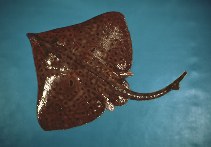| Family: |
Rajidae (Skates) |
| Max. size: |
163 cm TL (male/unsexed); max.weight: 18 kg |
| Environment: |
demersal; marine; depth range 0 - 750 m, oceanodromous |
| Distribution: |
Western Atlantic: Grand Bank and southern Gulf of St. Lawrence in Canada to North Carolina, USA. Threatened with extinction by intensive trawling (Ref. 27438). |
| Diagnosis: |
Disk broad, with sharply angled corners and a pointed snout; front edges concave. No middorsal spines on disk. Tail with 3 rows of spine (1 middorsal row and 1 row on each side). Dorsal fins close together (Ref. 7251). Upper surface brownish, with many scattered small dark spots. Mucous pores on nuchal region. Lower surface white, blotched irregularly with gray (Ref. 6902). |
| Biology: |
Occur from water's edge to 430 m depth; absent from shoal waters in south during warm months (Ref. 7251). Found in salinities that range from 35 along the continental edge to 31.5 inshore along the open coast and as low as 21-24 (Ref. 6902). Live on all kinds of bottom (Ref. 205). Benthic (Ref. 5951). Feed on bivalve mollusks, squids, rock crabs, lobsters, shrimps, worms and fishes. Oviparous. Distinct pairing with embrace. Young may tend to follow large objects, such as their mother (Ref. 205). Eggs are oblong capsules with stiff pointed horns at the corners deposited during summer (with 6-month development) in sandy or muddy flats (Ref. 205, Ref. 114953). Egg capsules are 7.1-13.2 cm long and 4.6-7.4 cm wide (Ref. 41250). Males reaches maturity at ca. 100 cm TL, females at 96-105 cm TL; hatch size at 18-19 cm TL (Ref. 114953). Little use is made of the small quantities that are caught. In some cases, they are made into fish meal. |
| IUCN Red List Status: |
Least Concern (LC); Date assessed: 20 June 2019 Ref. (130435)
|
| Threat to humans: |
harmless |
Source and more info: www.fishbase.org. For personal, classroom, and other internal use only. Not for publication.
